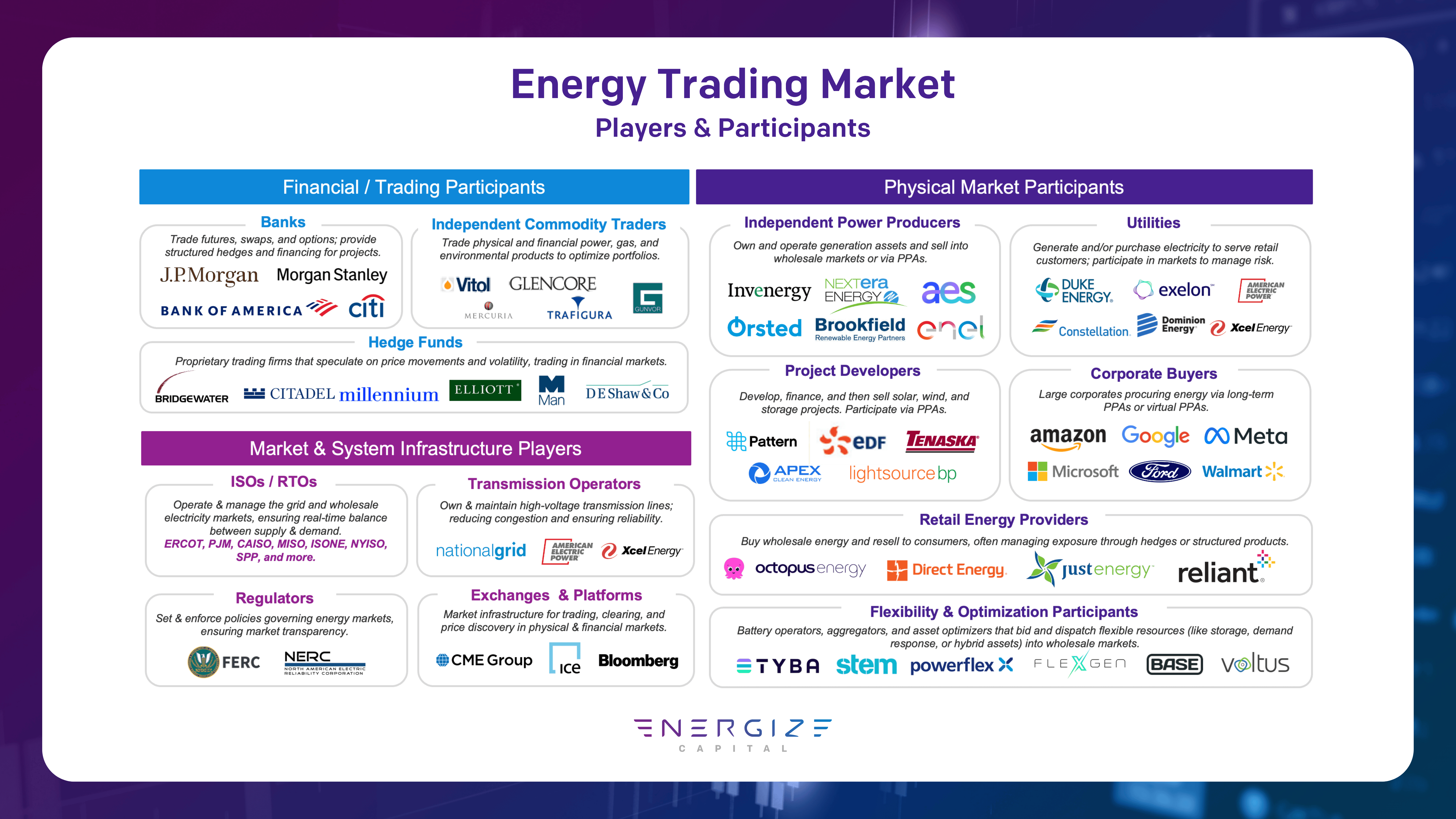
Once defined by reliable patterns, energy trading is now a fast-evolving global market shaped by new volatility, diversified power sources, and emerging players. In this changing landscape, we’re seeing growing demand for a new software stack to power the next generation of trade planning, execution, and reconciliation.
The way electricity is bought, sold, and balanced is entering a period of historic change. Until recently, energy trading infrastructure was designed around large, centrally dispatched thermal plants and predictable demand. This architecture favored reliability and long planning cycles, which could be serviced through day-ahead bidding, long term contracts, and manual transaction management. But with an increasingly electrified, decentralized, and transmission-constrained grid, that model is breaking down. Record deployment of solar and wind has introduced variable generation, and new participants—including data center developers—add complexity and volatility. At the same time, extreme weather events have pushed price swings to historic highs. As a result, an industry once centered on spreadsheets and phone calls is now struggling to meet the speed, data-intensity, and granularity that today’s market demands.
Market factors driving a new chapter of energy trading:
As all these forces reshape the market, new entrants, ranging from Citadel to Meta, have stepped onto the scene. Merchant traders, hyper scalers, and hedge funds are all breaking into the wholesale power-trading market, deepening liquidity and boosting demand for more sophisticated, data-driven digital solutions.

We see software and services as key enablers of this new trading ecosystem. By improving planning, execution, and reconciliation of transactions, these solutions will modernize a growing industry, thus improving the economics of an evolving energy mix and improving the resilience of our critical systems.
Today’s energy traders are facing a new portfolio of challenges across the deal lifecycle, from pre-trade planning to trade execution to post-trade reconciliation. Luckily, both earlier-stage startups and later-stage innovators are building solutions to catalyze the next generation of trading.
Reliable forecasting is the foundation of profitable trading. Historically, traders relied on public weather forecasts, proprietary models, and manual spreadsheets. But, today’s grid demands high‑resolution forecasting that captures the intermittency of wind and solar, variations in nodal prices due to grid congestion, the impact of extreme weather, and the behavior of flexible loads.
Software Solutions: Improved data aggregation and analytics, coupled with AI-based models, are stepping in to reimagine weather and energy forecasting. Amperon provides improved weather-informed forecasting across demand, generation and price, while Grid Status delivers real-time and historical ISO market data—giving traders a live view of prices, generation mix, and congestion to inform trading decisions. Simultaneously, scaled innovators like MetDesk are leveraging advanced weather services to deliver actionable trading insights and scale solutions offerings across global markets.
While ISO dispatch and settlements already occur at minute level intervals, most financial and bilateral markets still trade in multi-hour blocks, which struggle to capture the sub-hourly price volatility now driven by renewables, congestion, and weather. Traders increasingly need tools that allow hedging within the hour and across specific nodes or zones. Slow-moving platforms and broker-driven OTC markets can leave participants unable to manage exposure or execute orders quickly enough to match real-time market movements.
Software Solutions: Innovative solutions like ElectronX are building next-generation electricity exchanges and clearinghouses designed to increase liquidity and flexibility in power markets. With hourly and intraday derivative contracts, participants can hedge sub-hourly price risk and manage volatility with greater precision. enmacc is digitizing legacy OTC workflows—replacing email-based communication with a Request-For-Quotes (RFQ) protocol for price discovery, negotiation, and execution. The model enhances efficiency and transparency while reducing friction in market interactions.
After trades are executed, firms must reconcile millions of transactions under tightening risk and reporting requirements. Legacy Energy Trading and Risk Management (ETRM) systems struggle with growing data volumes, multi-commodity portfolios, and compliance obligations, leading to operational bottlenecks and potential financial exposure.
Software Solutions: Modernized ETRMs serve to automate reconciliation and improve visibility across the trading ecosystem. For example, Molecule provides API-based architectures to provide real-time transparency across trade portfolios, integrating with external data sources and supporting configurable add-on modules for different asset classes. PCI Energy Solutions is also modernizing ETRM with cloud-native, power-specific systems that integrate risk analytics, compliance automation, and renewable portfolio management.
Energy trading sits at the nexus of the electrification and digitization megatrends. Volatility from extreme weather and intermittent energy resources, rapid load growth, and increasingly complex market structures are all reshaping how electricity is bought and sold. Software is emerging as the indispensable catalyst to this transition - enhancing forecasting accuracy, enabling granular and faster trades, and automating back‑office processes. With modern digital solutions, the energy trading landscape can move into the modern era, bolstering the economics of our diversifying energy mix and safeguarding the infrastructure we rely on.